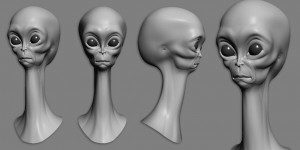The following excerpt is a sneak preview of my current work-in-literary-progress, ‘How to Sit in a Chair’ is a book I’ve been working on for some years. I thought I’d share it with you, if only to fish for feedback and criticism. Even though this work remains unpublished, it is covered by the copyright of this website, and as such may not be copied in whole or in part without expressed, written permission.
“It is our creation
And like all things we see
Is made up of the same stardust
As you and me
Look around you, what do you see? Furniture? Possibly a chair or two? Small objects, big objects, soft things, hard things, people, animals, plants, earth, and even stars if you look up.
You are surrounded by the miracle (and I use that word loosely) of the universe. Every particle of every atom, of every cell, of every thing came from the same small source, billions upon billions of years ago. It seems strange to use a human convention, the word years, to describe the evolution of the cosmos, but such as we are, we will have to remain. Somewhere between five and six billion years have passed since that first galactic event, The Big Bang; an explosion, so vast it sprayed cosmic elements across an expanding area so vast that our minds are largely incapable of comprehending its size. So much so that I won’t even try to illustrate it.
Since that initial event, regardless of its cause, time has worked its magic. Floating disks of gas slowly combined in empty space, they captured more gasses, combining elements in ways that now seems so basic. As progress held its course, these gas disks compressed under the growing forces of gravity, driving elemental gasses together with such pressure that the first chemical reactions took place, eventually becoming the bright stars we see in the heavens above the earth.
This process was crushingly violent, though cosmically slow. Over times’ course, the pressures that created the stars served to force the chemical processes which created elemental by-products; hydrogen and helium, as well as heavier components such as iron and carbon. These elements make up everything in the universe. They, together with all of the base elements on the periodic table, are the foundation of every celestial body our minds can conceive and our technology can scan.
We too, are made from the dust of stars; our wondrous evolution was made possible through the most violent of acts. We are the children of a cosmic accident (in more ways than one, quite possibly), and in that spirit we move on, we grow and learn and build.
As mentioned earlier, everything you can see, touch and experience is made up of the same stuff; Carbon is the building block, but the atom is the engineer.
Atoms, with neutrons and protons and nuclei; spinning, vibrating and orbiting, make up everything you can see and experience. The subtle difference between your rear-end and the chair it rests on, is the simple matter of a vibrational frequency. Essentially, the frequency of vibration of an atom and it’s complementary nucleic particles, determines it’s alignment with other atoms, and through that process, determines what type of matter it makes up on a macro scale. Though, again, the difference on the atomic scale is almost negligible, and in effect reduces the difference between you and your chair to semantics.
Does that reduce your intrinsic meaning? No, not necessarily. That subtle difference between you and your chair is the same as the difference between you and a bar of gold, or your chair and the body of a Lamborghini. Though, as we move up the scale of magnification on both your body and the chair, the effect of those differences becomes apparent and undeniable. The similarities are also highlighted; you are both made up of biological matter, reinforced by elemental matter, and at different times, you are both energized by the power of the sun’s radiation.
The fact that you and your chair are made up of the same special stuff, the same stuff that makes up everything in the universe, means that you are both governed by the same laws of physics. You are both at the mercy of gravity, you are both limited by the speed of light, and you’re both subject to the weird rules of time. My lack of understanding in the science of non-Euclidian geometry not withstanding, I’ll spare you the tedium of a mathematical assessment of your chair, and its interaction with the environment at large, and in place I’ll open the door a little further to exploring the physics and biology of the chair.
Empty space is especially intriguing, and at reading that statement you might wonder if I’m making a joke of some kind; let me reassure you, I’m not.
When you think of matter, you most likely imagine a solid thing, an object, a fluid, a person or a planet. But there is much more to matter than meets the eye. If you close your eyes and imagine the atomic structure of matter, do you envision a cluster or grouping of tiny atoms, stuck together, standing shoulder-to-shoulder in a huddle, straining against the varied forces of nature to maintain the shape they hold?
What if I told you that the molecular structure of matter contains more empty space than solid mass?
Consider that the molecular structure of a chunk of rock resembles a single molecule, standing alone on the centre of a professional football field in a large NFL stadium, and his next closest kin stands on the edge of the stadium’s parking lot.
That’s a lot of empty space. So much so that the mind can scarcely believe it’s true, for if there is that much distance between molecules, why does anything appear solid?
The same applies to your chair, more empty space than solid mass, in fact, far more empty space than that of the rock. So much empty space that the lonely NFL fan molecule’s closest kin would be several city blocks away. While you consider what that means, try not to think about what’s keeping them connected.
Perspective is everything in the universe, if you and I were naturally tiny enough for us to see the molecular structure of our chair, without the aid of a very powerful microscope, we would certainly have no need of a chair any longer, but then our perspective would be such that the empty space would seem most practical.
As it is, our perspective has necessitated the need for objects with mass to appear completely solid, hence, the chair can support your tush for while longer.
Where would we be without Sir Isaac Newton? Well, probably right where we are, we’d just be a little worse off is all. Where would we be without gravity? Better yet; what would we be without gravity? This would be very different indeed. Gravity defines life on earth; it binds us to our planet and binds our planet to its position in the solar system. It also binds our sun in its position relative to the rest of the universe, even though that position is ever changing; gravity is what makes everything make sense for us. It is a constant in our universe (though cutting edge science is beginning to refute that idea) and it dictates what we can and can’t do.
It governs our weight, relative to our atmosphere, it provides the means to assign a value to mass, and in fact it was the first invisible phenomena of our universe to be detected, categorized and measured. In essence, gravity is the reason we’re here at all.
Without gravity, the chemical wastes spewed out by our sun billions of years ago, would never have had the chance to connect, to congeal and to ultimately form a solid. Without gravity, hydrogen and oxygen molecules could never have condensed to create water, and well, without water, we don’t exist. Gravity is the ultimate designer too, it provided the means by which plants grow their many varied structures, and eons ago it forced early sea creatures to adapt their biology in order to survive on land (among other things).
It restricts us as well; it says we can’t fly, and proves it every time we jump off a cliff. Gravity gave birds the advantage of flight, but they tricked it by reducing their mass by way of hollow, non-dense bones, making them light enough to glide on air currents while big enough to survive.
And in this way, gravity has shaped the chair. This one constant demanded that we abide by its laws and be governed by the pressure of the universe pushing down on us. Inevitably, we got tired and decided to sit down, and the chair was there to support us in our time of need. Its structure is sturdy, four legs (though sometimes not), supporting a seat, a back support (or not) and possibly some arm rests, all of which are under the same pressures as us, they feel the same weight, the same pull as us, and yet, the chair holds us. In structure and form, the chair defies gravity.
This is no big deal you say; after all, most everything on earth defies gravity in some way or another, and you may be right…in fact, you are right. It’s nothing special, until you think of life without gravity!
Amorphous blobs of proto-matter, floating, hovering and clinging to the atmosphere. They resemble giant three-dimensional pools of toxic waste. They’re grey, sticky in texture and seemingly lifeless, until you hear it. It’s quiet at first, a low rumble, like the infancy of some great gurgling burp in the belly of a bar-stool football fan. The rumbling gets louder, it creates sound waves that resonate deep inside you, and soon it becomes a deafening boom, over and over, and through all this invisible commotion, you finally see it; the grey blobs of matter begin to move, slowly at first, but they pick up speed, moving away from you, changing shape and propelling themselves by sound waves.
On this strange planet, gravity, or the lack thereof, helped evolution create a very different animal population. They didn’t feel the force of gravity pushing them toward the earth, they didn’t have to fight against their own weight to move through their environment, and as a result, natural selection took them on very different paths of evolution than us. They have no need for legs or supportive structures; they have no need of limbs at all, for locomotion or for any other reason. Theirs is an existence of weightless leisure, though I’m certain they face perils none-the-less. Weather patterns exist on even the most barren and alien worlds we know, so for sure, this planet would suffer the same changing winds, and I would imagine a species whose life is spent hovering above the surface of the ground, would be acutely affected by the winds.
Consider the chair in such an environment, it would be utterly absurd. To confine ones self to the rigid formality of furniture, when the atmosphere is more than supportive and much more appealing; who would do such a thing? Though, if a higher intelligence evolved in such a place, would they not have need to structure and organize the things in their lives? The acquisition and collecting of things may be uniquely human, and it may be limited to us because of our gravitational environment. In our gravity, things generally stay where we put them, though not necessarily so on a low or zero gravity world.
This is only one end of the gravitational spectrum however, what about life on giant planets, whose gravitational fields are many hundreds of times greater than that on earth? Can life survive in that environment? The answer is yes, resoundingly; we know from the study of extremophiles here on earth -a growing field of micro biology studying single celled and some multi-cellular but simple life forms mainly classified on both the archaea and eucharyote branches of the biological tree of life – that species of microbial life, such as bacteria and protists, thrive in the vast and crushing depths of our deepest oceans, huddled near geothermal vents in the sea floor, and virtually unchanged for the past billion years. Life can, and does, exist and flourish in such extreme environments. So what does that mean for the chair?
One would imagine that the demands of survival in such crushing gravity would necessitate the development of very small organisms, creatures whose structures must be dense enough to survive the atmospheric pressure, yet small enough to ensure their super dense mass doesn’t make movement impossible where necessary. Very little in this environment would venture above the crust of the planets surface, and most life would exist inside protective rock formations. It, again, would be ridiculous to conceive of such life making use of chairs.
These are two extremes however, and while we may not reside at the mean mark of the universes’ gravitational spectrum, we are at least living in the only environment that we could possibly have survived.
Mankind, even among the many thousands of species of life here on earth, is exceedingly fragile, we are frail and weak compared to our evolutionary counterparts, we are naturally ill-equipped to survive even in the environments we continually inhabit. Outside of a small swath of tropical and sub-tropical locales around the equatorial belt of this spinning blue ball, humans would surely perish if left to survive only with our uncovered flesh exposed to the elements, anywhere but within walking distance of a sandy white beach. Indeed, just beyond that beach is a soup of oceanic life, teaming with diversity and evolutionary adaptability, all of it surviving and thriving in an environment that is in direct opposition to that which is necessary for our own survival, and none of it, not a single species other than man, has ever seen fit to design, construct and use a chair of any kind.
It’s our big brains which leave us seated high at the top of the remedial food chain, not by brute force or natural predatory skill, but by ingenuity alone. We adapt at a rate far faster than any creature ever known to this small planet of ours. Through that adaptation, we have collectively harnessed the power of physics; we’ve manipulated, tweaked and experimented with those immutable laws, and used them to our advantage. Thanks to that adaptability, we now inhabit nearly every corner of the globe, largely changing the face of the environment with the core purpose of protecting our fragile selves from the harshness of that same ecology. We change everything we see and everything we touch, we force it all to become our slave, slaves to comfort, slaves to aesthetics, and slaves to progress; the chair is no different.
Whatever its shape, whatever its size, we can all recognise its form as that of a chair. Its purpose, clearly, is to be sat in. To support us, to provide respite and shelter from the long journey of life that has left us weary and tired, or to house our ingenuity as we careen recklessly down the varied roads of life.”
 A great rumble breaks the silence of an early morning sunrise as the Earth’s crust heaves and cracks. Buildings creak and sway, windows break, furniture collapses and people begin to take cover. It’s an Earthquake, and it’s a common experience in some parts of the world. While Earthquakes can strike literally anywhere on Earth, there are places that are prone to a great deal more tectonic activity than others, and in the wake of the terrible tragedy in Japan this spring, one cannot help but conjure images of death and destruction.
A great rumble breaks the silence of an early morning sunrise as the Earth’s crust heaves and cracks. Buildings creak and sway, windows break, furniture collapses and people begin to take cover. It’s an Earthquake, and it’s a common experience in some parts of the world. While Earthquakes can strike literally anywhere on Earth, there are places that are prone to a great deal more tectonic activity than others, and in the wake of the terrible tragedy in Japan this spring, one cannot help but conjure images of death and destruction.
 Conspiracy theorists are now grabbing hold of the idea, especially in the wake of reports that earthquake lights were seen just prior to the recent Japan earthquake and tsunami, and are suggesting that there is a sinister plot involved. For years now, conspiracy theorists have been blaming the High Frequency Active Auroral Research Program or HAARP for a host of natural disasters and other phenomenon, and one can’t help but draw a line connecting the idea of earthquake light and HAARP, though seeing a possible connection is only one part of the puzzle.
Conspiracy theorists are now grabbing hold of the idea, especially in the wake of reports that earthquake lights were seen just prior to the recent Japan earthquake and tsunami, and are suggesting that there is a sinister plot involved. For years now, conspiracy theorists have been blaming the High Frequency Active Auroral Research Program or HAARP for a host of natural disasters and other phenomenon, and one can’t help but draw a line connecting the idea of earthquake light and HAARP, though seeing a possible connection is only one part of the puzzle. Jointly funded by the US Air Force, the US Navy, the University of Alaska and DARPA (Defense Advanced Research Projects Agency) and located in the arctic, HAARP’s official purpose is to analyze the ionosphere and investigate the prospect for developing ionospheric enhancement technology to improve radio communications and surveillance around the globe. But whatever the official story is, conspiracy theorists are adamant that HAARP’s true purpose is much more malevolent. A great many people are convinced that HAARP is developing technology and weaponry that can cause earthquakes with pinpoint accuracy, among other such ideas.
Jointly funded by the US Air Force, the US Navy, the University of Alaska and DARPA (Defense Advanced Research Projects Agency) and located in the arctic, HAARP’s official purpose is to analyze the ionosphere and investigate the prospect for developing ionospheric enhancement technology to improve radio communications and surveillance around the globe. But whatever the official story is, conspiracy theorists are adamant that HAARP’s true purpose is much more malevolent. A great many people are convinced that HAARP is developing technology and weaponry that can cause earthquakes with pinpoint accuracy, among other such ideas.




 Please, please, please, let 2014 be the year of reason, of critical thinking and common sense.
Please, please, please, let 2014 be the year of reason, of critical thinking and common sense. When you consider some classical hoaxes, from the Piltdown Man, or Orson Wells’ War of Worlds radio show, there seem to be obvious motivators that the perpetrators clung to in their planning and execution. Whether malicious in nature or purely innocent, these scenarios have typically been born of a desire to make the punch line stick. Of the two examples given above, whomever the hoaxer of the Piltdown bone fragments actually was, it seems clear that the intention was to ridicule and embarrass the paleontological scholars involved in examining the found materials. Orson Wells however, had innocent intentions; he simply wanted to entertain and, perhaps, took his good humour a little far (though some suggest that the real hoax is that the ensuing panic never actually happened, or is that yet another hoax?). In the end though, in both cases the purpose seems to have been to get a good laugh on the part of the hoaxer.
When you consider some classical hoaxes, from the Piltdown Man, or Orson Wells’ War of Worlds radio show, there seem to be obvious motivators that the perpetrators clung to in their planning and execution. Whether malicious in nature or purely innocent, these scenarios have typically been born of a desire to make the punch line stick. Of the two examples given above, whomever the hoaxer of the Piltdown bone fragments actually was, it seems clear that the intention was to ridicule and embarrass the paleontological scholars involved in examining the found materials. Orson Wells however, had innocent intentions; he simply wanted to entertain and, perhaps, took his good humour a little far (though some suggest that the real hoax is that the ensuing panic never actually happened, or is that yet another hoax?). In the end though, in both cases the purpose seems to have been to get a good laugh on the part of the hoaxer. 2009’s Balloon Boy hoax is a good example of a hoax that not only went too far, but also defies any attempt to reason through their motivations. Why do what they did? The obvious answer is to achieve that 15 minutes of fame to which we’re each entitled. But is that hollow recognition really the primary motivator for hoaxing?
2009’s Balloon Boy hoax is a good example of a hoax that not only went too far, but also defies any attempt to reason through their motivations. Why do what they did? The obvious answer is to achieve that 15 minutes of fame to which we’re each entitled. But is that hollow recognition really the primary motivator for hoaxing? Feldman says that in his study 60 percent of participants lied at least once during a 10 minute conversation. The majority of participants, denied having said anything untruthful, and were genuinely surprised when video footage was replayed. Feldman says that lying is, at this level, a subconscious reflex used to maintain self-esteem, not only from the perspective of others but from themselves as well.
Feldman says that in his study 60 percent of participants lied at least once during a 10 minute conversation. The majority of participants, denied having said anything untruthful, and were genuinely surprised when video footage was replayed. Feldman says that lying is, at this level, a subconscious reflex used to maintain self-esteem, not only from the perspective of others but from themselves as well. Ultimately, from this list, it would have to be that they’re attempting to boost their own self-esteem, but I would suggest that this list is inadequate to answer our question. It certainly seems like, with most hoaxes, that the people involved are trying to bolster their own self-esteem by lording such falsities over the heads of the public, at least those in the public who entertain such things, so as to feel superior to those who weren’t capable of “seeing the truth” as it were. It seems more than a lie, it seems a manipulation of people’s beliefs and fears in some cases. It seems a feature of the anti-establishment movement and a method for pushing misinformation into the discussion for the purpose of derailing productive discourse. It seems political and self-serving and deleterious, and if we look at individual hoaxes, we can see elements of all of the above, but it doesn’t seem like any of them can be considered the one true culprit.
Ultimately, from this list, it would have to be that they’re attempting to boost their own self-esteem, but I would suggest that this list is inadequate to answer our question. It certainly seems like, with most hoaxes, that the people involved are trying to bolster their own self-esteem by lording such falsities over the heads of the public, at least those in the public who entertain such things, so as to feel superior to those who weren’t capable of “seeing the truth” as it were. It seems more than a lie, it seems a manipulation of people’s beliefs and fears in some cases. It seems a feature of the anti-establishment movement and a method for pushing misinformation into the discussion for the purpose of derailing productive discourse. It seems political and self-serving and deleterious, and if we look at individual hoaxes, we can see elements of all of the above, but it doesn’t seem like any of them can be considered the one true culprit. Anyone who knows me, or perhaps who is a regular reader, knows that I have an affinity for big hairy hominids. Well, actually, I should probably clarify, there’s one particular big hairy hominid that I have in mind, not just dudes with a lot of back hair. I’m referring to Bigfoot, or Sasquatch if you prefer.
Anyone who knows me, or perhaps who is a regular reader, knows that I have an affinity for big hairy hominids. Well, actually, I should probably clarify, there’s one particular big hairy hominid that I have in mind, not just dudes with a lot of back hair. I’m referring to Bigfoot, or Sasquatch if you prefer. In that vein, I tuned in to Spike TV’s newest reality show last night, the 10 Million Dollar Bigfoot Bounty, starring Dean Cain. This show has been hyped in style over the last several weeks, especially among Bigfooters and their associated blogs and online communities, of which I am not necessarily a member. It had been promised that it would be a serious effort to find talented people, who are, after all is said and done, more likely than most to actually find that elusive evidence of Sasquatch. We’ve been promised that the cast and producers will take a pointedly scientific tact and that the whole thing will be treated as a scientific endeavour, rather than a TV spectacle.
In that vein, I tuned in to Spike TV’s newest reality show last night, the 10 Million Dollar Bigfoot Bounty, starring Dean Cain. This show has been hyped in style over the last several weeks, especially among Bigfooters and their associated blogs and online communities, of which I am not necessarily a member. It had been promised that it would be a serious effort to find talented people, who are, after all is said and done, more likely than most to actually find that elusive evidence of Sasquatch. We’ve been promised that the cast and producers will take a pointedly scientific tact and that the whole thing will be treated as a scientific endeavour, rather than a TV spectacle.


 I suppose this is all part of the TV hook though, it gets the viewer riled up and passionate about the contestants and the show, and keeps them coming back for more.
I suppose this is all part of the TV hook though, it gets the viewer riled up and passionate about the contestants and the show, and keeps them coming back for more.
 Some particularly gruesome incarnations of the alien invasion scenario have flooded our movie theatres of late, though this is nothing new. Hollywood and by extension, western culture, has been obsessed with the subject of violent contact with extraterrestrials for decades. Even before the advent of moving pictures on the silver screen Orson Welles presented his listening audience with a fright they never forgot, in his adaptation of H.G. Wells’ classic novel The War of the Worlds. One thing Hollywood has made clear is their caricature of humanities fear of visitation from another world.
Some particularly gruesome incarnations of the alien invasion scenario have flooded our movie theatres of late, though this is nothing new. Hollywood and by extension, western culture, has been obsessed with the subject of violent contact with extraterrestrials for decades. Even before the advent of moving pictures on the silver screen Orson Welles presented his listening audience with a fright they never forgot, in his adaptation of H.G. Wells’ classic novel The War of the Worlds. One thing Hollywood has made clear is their caricature of humanities fear of visitation from another world. Even in-so-far as there are those among us who are unable or unwilling to discern between the truths of fiction and the falsities of reality, many have speculated on just what form such a visitation might take. Ultimately such speculation becomes a prediction (however un-provable) about not only the existence of, but the nature of extraterrestrial life in the universe. The sciences of Astronomy and Cosmology and Theoretical Physics have given us glimpses of what may be elsewhere in the cosmos. They speak of the probability of organic life being spread throughout our galaxy and beyond. They speak of the likely development of such life and the best-case chances of such life developing to some point that we might call it intelligent. And in fact the learned men, such as Stephen Hawking, Carl Sagan, Brian Green, Chris Impey, may be the best theoretical chance we have of defining exactly what or who we might face in the deep, dark void of space.
Even in-so-far as there are those among us who are unable or unwilling to discern between the truths of fiction and the falsities of reality, many have speculated on just what form such a visitation might take. Ultimately such speculation becomes a prediction (however un-provable) about not only the existence of, but the nature of extraterrestrial life in the universe. The sciences of Astronomy and Cosmology and Theoretical Physics have given us glimpses of what may be elsewhere in the cosmos. They speak of the probability of organic life being spread throughout our galaxy and beyond. They speak of the likely development of such life and the best-case chances of such life developing to some point that we might call it intelligent. And in fact the learned men, such as Stephen Hawking, Carl Sagan, Brian Green, Chris Impey, may be the best theoretical chance we have of defining exactly what or who we might face in the deep, dark void of space.

 Further, it would be entirely conceivable that such alien visitors could have evolved apparatus and biological processes for uses that we would find truly alien. In this vein one can imagine many such mechanisms: something equivalent to the mysterious human psi abilities, or rapid regeneration, and even the emission of plasmatic or acrid or totally unimaginable materials….just to name a few. Though as has been presented in recent films, any special abilities that our visiting aliens might possess, would be entirely incidental and any negative effect that they might have on Earth’s biology would be coincidental at best. As will be discussed later, it is inconceivable that an alien race could specifically evolve abilities that are specially adapted to aid or hinder human physiology, since our physiology would have had no impact whatsoever on the process of natural selection on their world.
Further, it would be entirely conceivable that such alien visitors could have evolved apparatus and biological processes for uses that we would find truly alien. In this vein one can imagine many such mechanisms: something equivalent to the mysterious human psi abilities, or rapid regeneration, and even the emission of plasmatic or acrid or totally unimaginable materials….just to name a few. Though as has been presented in recent films, any special abilities that our visiting aliens might possess, would be entirely incidental and any negative effect that they might have on Earth’s biology would be coincidental at best. As will be discussed later, it is inconceivable that an alien race could specifically evolve abilities that are specially adapted to aid or hinder human physiology, since our physiology would have had no impact whatsoever on the process of natural selection on their world.
 An extraterrestrial however, could not necessarily be said to be sustained by light and its derivatives as we are. Though if an alien did exist which did rely on solar radiation for survival, it would not necessarily follow that such an alien would be sustained by the specific type of radiation being expelled by our sun.
An extraterrestrial however, could not necessarily be said to be sustained by light and its derivatives as we are. Though if an alien did exist which did rely on solar radiation for survival, it would not necessarily follow that such an alien would be sustained by the specific type of radiation being expelled by our sun. From an admittedly anthropocentric position, it seems reasonable to claim that extraterrestrials likely will have eyes of some sort, though this is far from certain. If their environment is predominantly without light, we might find species that are kinetically sensitive to electromagnetic fluctuations in their immediate environment, much like many types of fish on Earth, including sharks. Or we might find that ET is visually able to detect light energy in a much larger band, say from low frequency radio waves to gamma ray radiation.
From an admittedly anthropocentric position, it seems reasonable to claim that extraterrestrials likely will have eyes of some sort, though this is far from certain. If their environment is predominantly without light, we might find species that are kinetically sensitive to electromagnetic fluctuations in their immediate environment, much like many types of fish on Earth, including sharks. Or we might find that ET is visually able to detect light energy in a much larger band, say from low frequency radio waves to gamma ray radiation.
 With the holiday season still hanging around in our rear view mirrors, many of us have embarked on the quintessential New Year’s resolution, the one that serves to line the pockets of fitness centre owners everywhere. That is, we ate too much during our winter solstice revelling and now we feel compelled to make at least a token effort to lose some weight. Well, some of us are, while some others (myself included) continue to stuff our faces well into the New Year.
With the holiday season still hanging around in our rear view mirrors, many of us have embarked on the quintessential New Year’s resolution, the one that serves to line the pockets of fitness centre owners everywhere. That is, we ate too much during our winter solstice revelling and now we feel compelled to make at least a token effort to lose some weight. Well, some of us are, while some others (myself included) continue to stuff our faces well into the New Year. No, this is not the introduction to a new weight loss scheme or a fad diet, but rather a discussion of the physics of weight, or mass to be specific.
No, this is not the introduction to a new weight loss scheme or a fad diet, but rather a discussion of the physics of weight, or mass to be specific. Using the above, one can in fact work out the weight of the Earth, or, more accurately, the mass of the Earth. And it turns out this is one heavy planet.
Using the above, one can in fact work out the weight of the Earth, or, more accurately, the mass of the Earth. And it turns out this is one heavy planet. Every bit of energy used on this planet comes from our sun, as in solar radiation energy. It is used either directly, as in photosynthesis or solar power collection, or even heat, or indirectly as in fossil fuels, or through the consumption of plant materials by animals etc. (There are other ways, of course, but this will suffice for the current discussion.) The same is true for electricity, whereas it’s either direct or indirect solar energy that initiates the flow of electrons in electric circuits, which by definition is electricity. Electrical systems make use of this flow by either powering components and thereby using up the indirect solar energy, or storing the potential of the energy in capacitors or batteries for later use.
Every bit of energy used on this planet comes from our sun, as in solar radiation energy. It is used either directly, as in photosynthesis or solar power collection, or even heat, or indirectly as in fossil fuels, or through the consumption of plant materials by animals etc. (There are other ways, of course, but this will suffice for the current discussion.) The same is true for electricity, whereas it’s either direct or indirect solar energy that initiates the flow of electrons in electric circuits, which by definition is electricity. Electrical systems make use of this flow by either powering components and thereby using up the indirect solar energy, or storing the potential of the energy in capacitors or batteries for later use. It can be scaled up though, and according to Michael from Vsauce in a video on his YouTube channel (see below), when you apply the same logic and mathematics to larger collections of digital information, say the internet as a whole, it turns out that such data weighs on the order of 12 grams or as much as the average strawberry.
It can be scaled up though, and according to Michael from Vsauce in a video on his YouTube channel (see below), when you apply the same logic and mathematics to larger collections of digital information, say the internet as a whole, it turns out that such data weighs on the order of 12 grams or as much as the average strawberry.